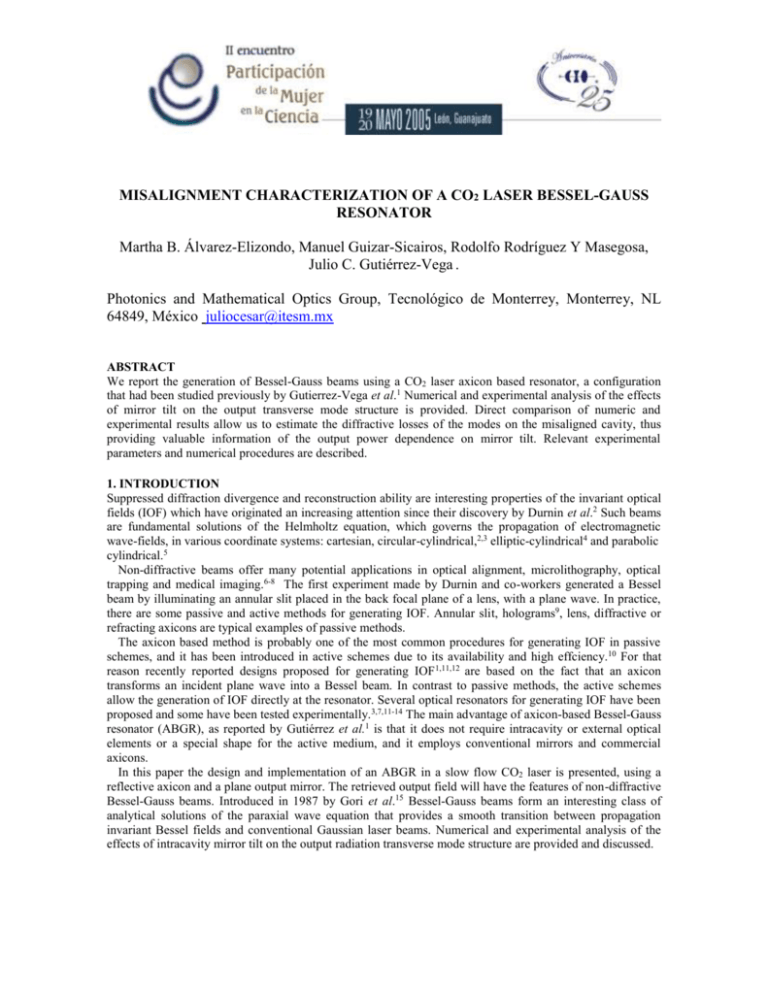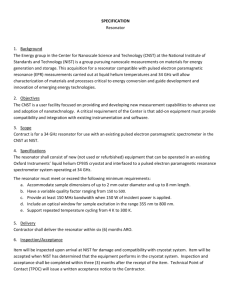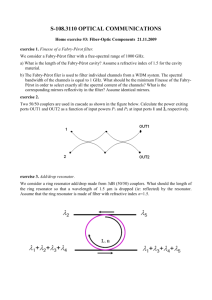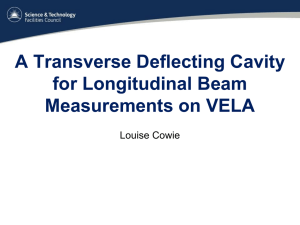Paper Title
advertisement

MISALIGNMENT CHARACTERIZATION OF A CO2 LASER BESSEL-GAUSS RESONATOR Martha B. Álvarez-Elizondo, Manuel Guizar-Sicairos, Rodolfo Rodríguez Y Masegosa, Julio C. Gutiérrez-Vega . Photonics and Mathematical Optics Group, Tecnológico de Monterrey, Monterrey, NL 64849, México juliocesar@itesm.mx ABSTRACT We report the generation of Bessel-Gauss beams using a CO2 laser axicon based resonator, a configuration that had been studied previously by Gutierrez-Vega et al.1 Numerical and experimental analysis of the effects of mirror tilt on the output transverse mode structure is provided. Direct comparison of numeric and experimental results allow us to estimate the diffractive losses of the modes on the misaligned cavity, thus providing valuable information of the output power dependence on mirror tilt. Relevant experimental parameters and numerical procedures are described. 1. INTRODUCTION Suppressed diffraction divergence and reconstruction ability are interesting properties of the invariant optical fields (IOF) which have originated an increasing attention since their discovery by Durnin et al.2 Such beams are fundamental solutions of the Helmholtz equation, which governs the propagation of electromagnetic wave-fields, in various coordinate systems: cartesian, circular-cylindrical,2,3 elliptic-cylindrical4 and parabolic cylindrical.5 Non-diffractive beams offer many potential applications in optical alignment, microlithography, optical trapping and medical imaging.6-8 The first experiment made by Durnin and co-workers generated a Bessel beam by illuminating an annular slit placed in the back focal plane of a lens, with a plane wave. In practice, there are some passive and active methods for generating IOF. Annular slit, holograms9, lens, diffractive or refracting axicons are typical examples of passive methods. The axicon based method is probably one of the most common procedures for generating IOF in passive schemes, and it has been introduced in active schemes due to its availability and high effciency.10 For that reason recently reported designs proposed for generating IOF 1,11,12 are based on the fact that an axicon transforms an incident plane wave into a Bessel beam. In contrast to passive methods, the active schemes allow the generation of IOF directly at the resonator. Several optical resonators for generating IOF have been proposed and some have been tested experimentally.3,7,11-14 The main advantage of axicon-based Bessel-Gauss resonator (ABGR), as reported by Gutiérrez et al.1 is that it does not require intracavity or external optical elements or a special shape for the active medium, and it employs conventional mirrors and commercial axicons. In this paper the design and implementation of an ABGR in a slow flow CO2 laser is presented, using a reflective axicon and a plane output mirror. The retrieved output field will have the features of non-diffractive Bessel-Gauss beams. Introduced in 1987 by Gori et al.15 Bessel-Gauss beams form an interesting class of analytical solutions of the paraxial wave equation that provides a smooth transition between propagation invariant Bessel fields and conventional Gaussian laser beams. Numerical and experimental analysis of the effects of intracavity mirror tilt on the output radiation transverse mode structure are provided and discussed. 3. MISALIGNED BESSEL-GAUSS RESONATOR The alignment sensitivity of this novel resonator is an important consideration for its design and construction. To estimate the laser system response to mirror misalignments, and their effects on the output transverse intensity and phase profiles, one could compute the lowest-loss bare cavity eigenmode with the iterative Fox and Li algorithm16, adding a corresponding linear phase to the mirror to account for a small angle tilt. Although this method provides the lowest-loss eigenmode three-dimensional field structure and thus allows an estimation of the loaded-cavity transverse profile, it is not suitable to compute modes with higher losses and there is no straightforward connection with the aligned barecavity modes that are commonly wellunderstood. Additionally, this method is ill-conditioned to the initial field and may have an intolerably slow convergence if two transverse modes supported by the cavity have nearly the same eigenvalue magnitude. It has already been shown that the eigenmodes supported by a resonant cavity can be computed by expanding these modes in terms of the fully aligned eigenmodes of the same cavity. 17 Although Bowers applies this method to an unstable resonator, completeness of the bare-cavity modes for an arbitrary resonator with one diffractive aperture has already been demonstrated by Oughstun. 18 We have modified this formulation to apply it to the Bessel-Gauss optical resonator in order to characterize its alignment sensitivity. In this approach it is assumed that all diffractive losses in the cavity occur at the output mirror and that the remainder of the optical elements encountered during a complete round-trip comprise a paraxial loss-less optical system that can be completely characterized by its ABCD matrix. For the particular application to the non-diffracting resonator, the axicon is used as a feedback mirror, its linear phase profile difficult its representation through the ABCD matrix, thus it should be represented as a finite lossy mirror by its complex amplitude reflectivity function (r), given by (1) (r ) exp(ik0 r ), where r denotes the transverse set of coordinates (r , ), k 2 / is the wave number and 0 is the reflective axicon wedge angle. We additionally assume that the output coupler is loss-less, this approximation is justified by its uniform high reflectivity. The bare-cavity modes of an arbitrary resonator n (r ) are computed at a reference plane just before reflection with the axicon and are solutions of the integral equation n n (r ) dr K (r , r ) n (r ), (2) where K (r , r ) is the kernel for propagating in the positive z direction along the unfolded cavity and n is the eigenvalue associated with the n-th resonator eigenmode. For a cavity with circular symmetry, the aligned cavity modes can be decomposed into azimuthal components ulp (r ) exp(il ), and in the Huygens-Fresnel approximation Eq. (2) may be reduced to a single integral over the radial coordinate ki l 1 a krr ik (3) Ar 2 Dr 2 lpulp r dr (r )ulp (r ) J l exp B 0 B 2B where a is the axicon radius, l and p are the azimuthal and radial mode indexes respectively, J l is the l-th order Bessel function of the first kind, and A, B and D are the elements of the ABCD matrix of the lens equivalent system. The modes of the aligned cavity are used as the basis set for computing the modes in the same cavity with misaligned mirrors. The bare misaligned cavity modes n (r ) can be obtained from Eq. (2), where the effect of mirror misalignment is included in the round-trip propagation kernel K (r , r ) . Assuming that they can be expanded in terms of the aligned cavity modes, the modes in the misaligned cavity are given by n (r ) A l p 0 u (r ) exp(il ) (n) lp lp (4) Using expression (4), Eq. (2) may be expressed as n Al(pn) K l p 0 2 l p,lp Alp ( n ) , (5) Figure 1. Eigenvalue magnitudes as a function of (a) the output mirror and (b) axicon tilt angle. and we obtain a direct expression for the expansion coefficients Alp ( n ) as a numerical eigenvalue problem for the array operator K l p,lp where the array elements are given by Kl p,lp drdr ul p (r ) exp(il ) K (r , r ) exp(il ) . (6) To numerically obtain the expansion coefficients a finite number of radial and azimuthal modes must be used as a basis set. Upon establishing a finite number of modes N, the double index lp, can be mapped to a single index m. Thus reducing Eq. (5) to a conventional matrix eigenvalue problem for each misaligned cavity eigenmode N n Am( n ) K m,m Am ( n ) , (7) m 1 and permitting the use of standard diagonalization techniques. Explicit expressions for array elements of K l p,lp are still required to compute the misaligned cavity eigenmodes, these expressions and the numerical computation technique will be now detailed. 3.1. Output mirror tilt In the equivalent lens-guide system of the non-diffractive resonant cavity a tilt α in the (y,z) plane may be accounted for by adding a linear phase shift exp(2ik y ) to the phase variation introduced by the mirror curvature. In this particular case the elements of K l p,lp are given by17 Kl p,lp a 2ik 2 L2 a 2 ik ik ik 2 exp rdr ( r ) u ( r ) exp Ar Ar 2 l p r dr (r )ulp (r ) exp B B 2 B 2 B 0 0 2k Lr 2k Lr krr i m J l m J m l Jm . B B B m (8) In order to numerically compute the array coefficients we use a plane mirror output coupler and axicon radius a = 2.54 cm and wedge angle θ = 0.5°. The number of aligned-cavity modes that are used on the basis set are determined by examining proper convergence of the misaligned-cavity mode eigenvalues λn, for angles smaller than 30 μrad we found that 78 modes were sufficient, with radial azimuthal indexes p 0,5 and l 6,6 respectively. Absolute values of the three lowest-loss misaligned-cavity mode eigenvalues for different output mirror tilts are depicted in Fig. 1(a). Notice that a transverse mode crossing of the lowest-loss eigenmode is predicted at approximately 24 μrad output mirror tilt. 3 Figure 2. Theoretical output patterns for several tilt angles and their experimental realizations. 3.2. Axicon tilt An axicon small tilt angle α may be accounted for by adding a linear phase shift on the equivalent lens system of the resonator at the axicon plane. For an small axicon tilt the elements of K l p,lp are given by17 ik K l p,lp 2 l p rdr (r )ul p (r )ulp (r ) exp ( A D )r 2 J l l (2k r ). 2 B 0 a (9) Figure 1(b) depicts the effects of axicon tilt on the misaligned-cavity mode eigenvalues, with a prediction of lowest-loss mode crossing at approximately 24 μrad. As depicted in Fig. 1, an important effect of mirror tilt is to destroy the azimuthal symmetry of the cavity which splits the degenerate modes 1( 1) that correspond to the p = 0, l= ±1 aligned cavity modes. Similarly to the typical stable and unstable optical resonators, the Bessel-Gauss optical cavity suffers a transverse-mode crossing at a critical tilt angle αc, although in this particular resonator αc is practically the same for axicon and output mirror tilt, this angle is in general different for each mirror. If the mirror is tilted beyond this critical angle, the induced azimuthal asymmetry causes a higher-loss aligned eigenmode to dominate the lowest-loss aligned-cavity mode. This particular behavior is depicted in Fig. 1, the computed transverse profiles of lowest-loss misaligned-cavity modes for different mirror tilts are compared to those obtained from the experimental setup in subsequent sections. 5. EXPERIMENTAL RESULTS In a conventional two spherical-mirror stable resonator the transverse electric higher-order modes (TEM00, TEM01, TEM10, etc.) can be obtained by tilting or shifting any of the spherical mirrors. These higher-order modes correspond typically to Hermite-Gaussian modes whose patterns exhibit a finite number of spots. The case when the resonator is perfectly aligned corresponds to the TEM 00 mode. In the case of Bessel-Gauss beams the corresponding lowest-order pattern is a set of circular fringes whose radial behavior is described by a zero order Bessel function. Once the cavity was aligned and a circularly symmetric multi-ringed output pattern was obtained, we slightly break the symmetry of the resonator by tilting the output coupler to generate higher-order modes. Figure 2 shows the measured intensity distributions of several high-order cavity modes for different angle tilts. Their corresponding theoretical predictions were computed by applying the theory developed in previous sections. The experimental patterns were measured using conventional thermal plates which can display the intensity distribution of the laser beam at real time. In the experiments we used a plate with range sensitivity from 0.4 to 2.4 W/cm2 and 100 lines/in resolution. In general the patterns exhibit a tendency to be aligned to the x or y axes when the output coupler is tilted. The experimental results shown in Fig. 2 closely resemble the typical transverse patterns of non-diffracting Mathieu-Gauss beams and also reveal that the astigmatism introduced in the resonator causes the higher-order 4 modes to be stationary transverse waves instead of the traveling rotating Bessel-Gauss waves. Direct inspection of Figure 2, reveals a good agreement between the measured and theoretical patterns. We have performed measurements at different planes to corroborate that the transverse shape maintains its nondiffracting profile. Regardless of the tilt and the spatial rotation of the patterns, the polarization of the output beam is linear since there are no surfaces in the simple cavity which could act as polarizers. It is well known that the field in the Fraunhofer plane of a focused non-diffracting beam corresponds to a circular ring whose amplitude and phase variations are given by its angular spectrum. Given the geometrical propagation parameters of the non-diffracting beam, the radius can be easily determined from the focal length of the focusing lens. To verify this fact for the case of our experiment, we have introduced a positive lens ( f 20 cm) in the propagation of the beam. We noticed that intensity of the obtained image at the focal plane of the focused mode is not uniform rather it presents an angular variation that resembles the angular Mathieu functions.4 BIBLIOGRAFÍA 1. J. C. Gutiérrez-Vega, R. Rodríguez and S. Chávez-Cerda “Bessel-Gauss resonator with spherical output mirror: geometrical and wave optics analysis,” J. Opt. Soc. Am. A, Vol. 20, 11, 2003, pp. 2113-2122. 2. J. Durnin, “Exact solutions for nondiffracting beams. I The scalar theory,” J. Opt. Soc. Am. A, Vol. 4, 4, 1987, pp. 651-654. 3. J. Durnin, J. J. Micely, Jr., and J. H. Eberly, “Diffraction free beams,” Phys. Rev. Lett., Vol. 58, 15, 1987, pp. 1499-1501. 4. J. C. Gutiérrez-Vega, M. D. Iturbe-Castillo, and S. Chávez-Cerda, “Alternative formulation for invariant optical fields: Mathieu beams,” Opt. Lett., Vol. 25, 20, 2000, pp. 1493-1495. 5. M. A. Bandrés, J. C. Gutiérrez-Vega, and S. Chávez-Cerda, “Parabolic nondiffracting optical wavefields,” Opt. Lett., Vol. 29, 1, 2004, pp. 44-46. 6. M. Erdélyi, Z. L. Horváth, G. Szabó, and Zs. BorVac, “Generation of diffraction-free beams for applications in optical microlithography,” Sci. Technol. B, Vol. 15, 2, 1997, pp. 287-292. 7. J. K. Jabczynski, “A diffraction-free resonator,” Opt. Commun., Vol. 77, 4, 1990, pp. 292-294. 8. Jian-yu Lu, Tai K. Song, Randall R. Kinnick, and J. F. Greenleaf, “In vitro and in vivo real-time imaging with ultrasonic limited diffraction beams,” IEEE Trans. Med. Imag., Vol. 12, 4, 1993, pp. 819-829. 9. J. Turunen, A. Vasara, and A. T. Friberg, “Holographic generation of diffraction-free beams,” Appl. Opt., Vol. 27, 19, 1988, pp. 3959-3962. 10. G. Scott and N. McArdle, “Efficient generation of nearly diffraction-free beams using an axicon,” Opt. Eng., Vol. 31, 12, 1992, pp. 2640-2643. 11. J. Rogel-Salazar, G. H. C. New, and S. Chávez-Cerda, “Bessel-Gauss beam optical resonator,” Opt. Commun., Vol. 190, 2001, pp. 117-122. 12. A. N. Khilo, E. G. Katranji, and A. A. Ryzhevich, “Axicon based Bessel resonator: analytical description and experiment,” J. Opt. Soc. Am. A, Vol. 18, 8, 2001, pp. 1986-1992. 13. K. Uehara and H. Kikuchi, “Generation of nearly diffraction-free laser beams,” Appl. Phys. B, Vol. 48, 11, 1989, pp. 125-129. 14. P. Pääkkönen and J. Turunen, “Resonators with Bessel-Gauss modes,” Opt. Commun., Vol. 156, 4, 1998, pp. 359-366. 15. F. Gori, G. Guattari, and C. Padovani, “Bessel-Gauss beams,” Opt. Commun., Vol. 64, 6, 1987, pp. 491-495. 16. A. G. Fox and T. Li, “Modes in a maser interferometer with curved and tilted mirrors,” Proc. IEEE, Vol. 51, 1963, pp. 80-89. 17. M. S. Bowers, “Eigenmodes of misaligned unstable optical resonators with circular mirrors,” Appl. Opt., Vol. 31, 9, 1992, pp. 1185-1198. 18. K. E. Oughstun, “On the completeness of the stationary transverse modes in an optical cavity,” Opt. Commun., Vol. 42, 1, 1982, pp. 72-76. 5







